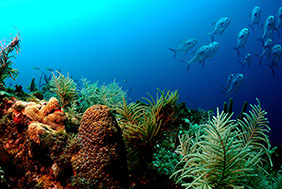-
Home
-
Data & Publications
-
Regional Portals
- About Regional Portals
- Florida
- Navassa Island
- Puerto Rico
- Flower Garden Banks
- U.S. Virgin Islands
- American Samoa
- Commonwealth of the Northern Mariana Islands
- Federated States of Micronesia
- Guam
- Main Hawaiian Islands
- Republic of the Marshall Islands
- Northwestern Hawaiian Islands
- Republic of Palau
- Pacific Remote Island Areas
-
CRCP Activities
- Glossary
National Coral Reef Monitoring Program Socioeconomic Monitoring Component: Summary Findings for Guam, 2023

The Socioeconomic Component of the National Coral Reef Monitoring Program (NCRMP) gathers and monitors a collection of socioeconomic data in seven U.S. coral jurisdictions. The team continued its second monitoring cycle with data collection in Guam in 2023, and recently released their report of summary findings along with two new infographics. The report summarizes current human dimensions information relevant to coral reef resources in Guam, as well as trends between the first (2016) and second monitoring cycles (2023). The report is accompanied by an infographic for the 2023 findings and a second infographic for the trends. Results are representative of the resident population of Guam as a whole, as well as strata for the northern and southern regions.
Household surveys conducted in January to April of 2023 revealed that Guam residents were familiar with a variety of threats to coral reefs and generally supported a range of potential management strategies, such as increasing community participation in natural resource management and implementing new requirements for improved wastewater treatment. Residents also supported the creation of new marine protected areas and generally believed they have led to a range of improved benefits for coral reefs and coastal communities.There was a general consensus that Guam's coral reefs are important to coastal protection, food, fisheries, human health, and culture. Residents were generally split on their perceptions of current conditions for ocean water quality, fish, live coral, and turtles, but over 35% believed the condition of each of these resources will worsen over the next ten years. Additionally, most resident households consumed seafood in some of their meals, and over half of those residents ate seafood from local coral reefs throughout the year. Surveys also showed that swimming/wading and beach recreation were primary activities for Guam residents in both 2016 and 2023, but frequency of participation in all activities declined in 2023.
Overall, the results indicate that Guam residents have important human connections to coral reefs and rely on these ecosystems for a variety of cultural and socioeconomic benefits. Results also suggest that residents want to see efforts to mitigate threats (e.g., pollution) to coral reefs and prevent resource conditions (e.g., ocean water quality, amount of live coral) from becoming worse. Targeted outreach, particularly about ocean acidification, climate change, and coral bleaching, could help increase awareness of threats to coral reefs, how those threats are linked to sustained benefits and quality of life, and what people can do to help conserve coral reefs.
Citation: M.E. Allen, C.S. Fleming, A. Alva, S.B. Gonyo, and E.K. Towle. 2024. National Coral Reef Monitoring Program Socioeconomic Monitoring Component: Summary Findings for Guam, 2023. U.S. Dep. Commerce, NOAA Tech. Memo., NOAA-TM-NOS-CRCP-51, 44p. + Appendices. https://doi.org/10.25923/819v-4s49.
Download Products
- Summary Findings for Guam, 2023 - Full Report
- Takeaways from the Guam 2023 Survey - Infographic (English)
- Takeaways from the Guam 2023 Survey - Infographic (CHamoru)
- Trends from Socioeconomic Surveying in Guam - Infographic (English)
- Trends from Socioeconomic Surveying in Guam - Infographic (CHamoru)
Related Project Information
- National Coral Reef Monitoring Program: Understanding Socioeconomic Connections
- National Coral Reef Monitoring Program: Guam Infographics


